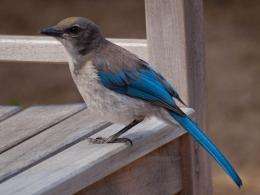September 3, 2012 report
Researchers find scrub jays congregate over dead

(Phys.org)—A small group of researchers from the University of California, Davis has found that a species of bird, the western scrub jay, responds to the presence of a dead specimen of one of their own, by calling out loudly to others of their kind and congregating around the body for up to day or two. The team, made up of T.L. Iglesias, R. McElreath and G.L. Patricelli discovered the birds' unique behavior by leaving dead jays in areas where the birds are known to exist and, as they describe in their paper published in the journal Animal Behavior, watching as they called out to others to join in, forming a loud aggregation.
In addition to leaving dead jays in observable places, e.g. back yards, the team also deposited stuffed jays and owls, as well as pieces of dead wood. The idea was to compare their reactions to different objects. They found that upon discovering the dead carcass of one of their own, the birds would fly down to be near it and call out to others who would eventually join them. The calls were apparently loud enough for other birds, long distances away, to hear and join in, creating what the team describes as a great "cacophonous aggregation."
The team noted that the birds also reacted to the stuffed specimens, calling out and aggregating around them but in a completely different way. When they spied the stuffed owl, a known predator, they called out in obvious alarm, alerting others to its presence. They did so when discovering the stuffed jays as well, but rather than behaving as if alarmed, they tried to drive it away, a normal behavior when encountering other birds that appear to be invading its territory, clearly believing it to be alive due to its upright stance.
Interestingly, the team also found that when the birds congregated around their lost compatriot, they ceased foraging, sometimes for as long as forty eight hours. The research group doesn't believe the congregating is a form of mourning, but is instead a way for the birds to convey to all of the others in the area, that some unidentifiable threat is about and that they all need to be on special heightened alert, at least for awhile.
More information: Western scrub-jay funerals: cacophonous aggregations in response to dead conspecifics, Animal Behaviour, dx.doi.org/10.1016/j.anbehav.2012.08.007
Abstract
All organisms must contend with the risk of injury or death; many animals reduce this danger by assessing environmental cues to avoid areas of elevated risk. However, little is known about how organisms respond to one of the most salient visual cues of risk: a dead conspecific. Here we show that the sight of a dead conspecific is sufficient to induce alarm calling and subsequent risk-reducing behavioural modification in western scrub-jays, Aphelocoma californica, and is similar to the response to a predator (a great horned owl, Bubo virginianus, model). Discovery of a dead conspecific elicits vocalizations that are effective at attracting conspecifics, which then also vocalize, thereby resulting in a cacophonous aggregation. Presentations of prostrate dead conspecifics and predator mounts elicited aggregations and hundreds of long-range communication vocalizations, while novel objects did not. In contrast to presentations of prostrate dead conspecifics, presentations of a jay skin mounted in an upright, life-like pose elicited aggressive responses, suggesting the mounted scrub-jay was perceived to be alive and the prostrate jay was not. There was a decrease of foraging in the area during presentations of prostrate dead conspecifics and predator mounts, which was still detectable 24 h later. Foraging returned to baseline levels 48 h after presentations. Novel objects and mounted jays did not affect foraging. Our results show that without witnessing the struggle and manner of death, the sight of a dead conspecific is used as public information and that this information is actively shared with conspecifics and used to reduce exposure to risk.
Journal information: Animal Behavior , Animal Behaviour
© 2012 Phys.org


















